Standards Worldwide
Standards Worldwide
Phone +49 30 58885700-07

Standard [CURRENT]
ASTM D 4739:2023
Standard Test Method for Base Number Determination by Potentiometric Hydrochloric Acid Titration
- Publication date
- 2023
- Original language
- English
- Pages
- 8
- Publication date
- 2023
- Original language
- English
- Pages
- 8
- DOI
- https://dx.doi.org/10.1520/D4739-23
Product information on this site:
Quick delivery via download or delivery service
Buy securely with a credit card or pay upon receipt of invoice
All transactions are encrypted
Short description
1.1 This test method covers a procedure for the determination of basic constituents in petroleum products and new and used lubricants. This test method resolves these constituents into groups having weak-base and strong-base ionization properties, provided the dissociation constants of the more strongly basic compounds are at least 1000 times than that of the next weaker groups. This test method covers base numbers up to 250. 1.2 In new and used lubricants, the constituents that can be considered to have basic properties are primarily organic and inorganic bases, including amino compounds. This test method uses hydrochloric acid as the titrant, whereas Test Method D2896 uses perchloric acid as the titrant. This test method may or may not titrate these weak bases and, if so, it will titrate them to a lesser degree of completion; some additives such as inhibitors or detergents may show basic characteristics. 1.3 When testing used engine lubricants, it should be recognized that certain weak bases are the result of the service rather than having been built into the oil. This test method can be used to indicate relative changes that occur in oil during use under oxidizing or other service conditions regardless of the color or other properties of the resulting oil. The values obtained, however, are intended to be compared with the other values obtained by this test method only; base numbers obtained by this test method are not intended to be equal to values by other test methods. Although the analysis is made under closely specified conditions, this test method is not intended to, and does not, result in reported basic properties that can be used under all service conditions to predict performance of an oil; for example, no overall relationship is known between bearing corrosion or the control of corrosive wear in the engine and base number. 1.4 This test method was developed as an alternative for the former base number portion of Test Method D664 (last published in Test Method D664 - 81). 1.4.1 Colorimetric test methods for base number are Test Method D974 , IP 139, and 5102.1 on acid and base number by extraction (color-indicator titration) of Federal Test Method Standard No. 791b. Test results by these methods may or may not be numerically equivalent to this test method. 1.5 The values stated in SI units are to be regarded as standard. No other units of measurement are included in this standard. 1.6 This standard does not purport to address all of the safety concerns, if any, associated with its use. It is the responsibility of the user of this standard to establish appropriate safety, health, and environmental practices and determine the applicability of regulatory limitations prior to use. 1.7 This international standard was developed in accordance with internationally recognized principles on standardization established in the Decision on Principles for the Development of International Standards, Guides and Recommendations issued by the World Trade Organization Technical Barriers to Trade (TBT) Committee.
ICS
71.040.40
DOI
https://dx.doi.org/10.1520/D4739-23
Loading recommended items...
Loading recommended items...
Loading recommended items...
